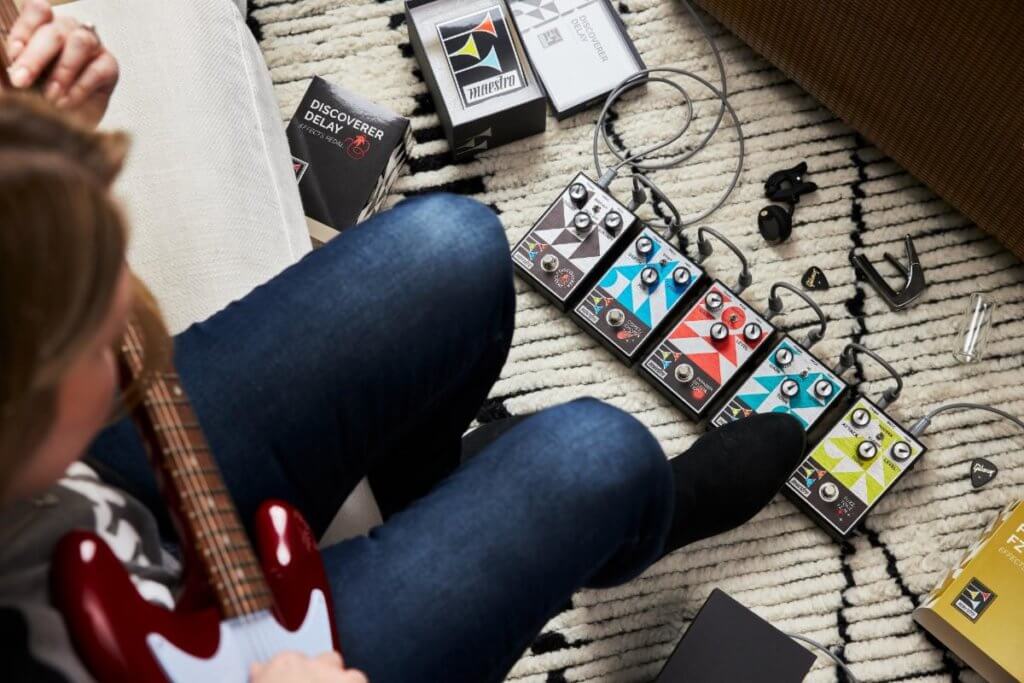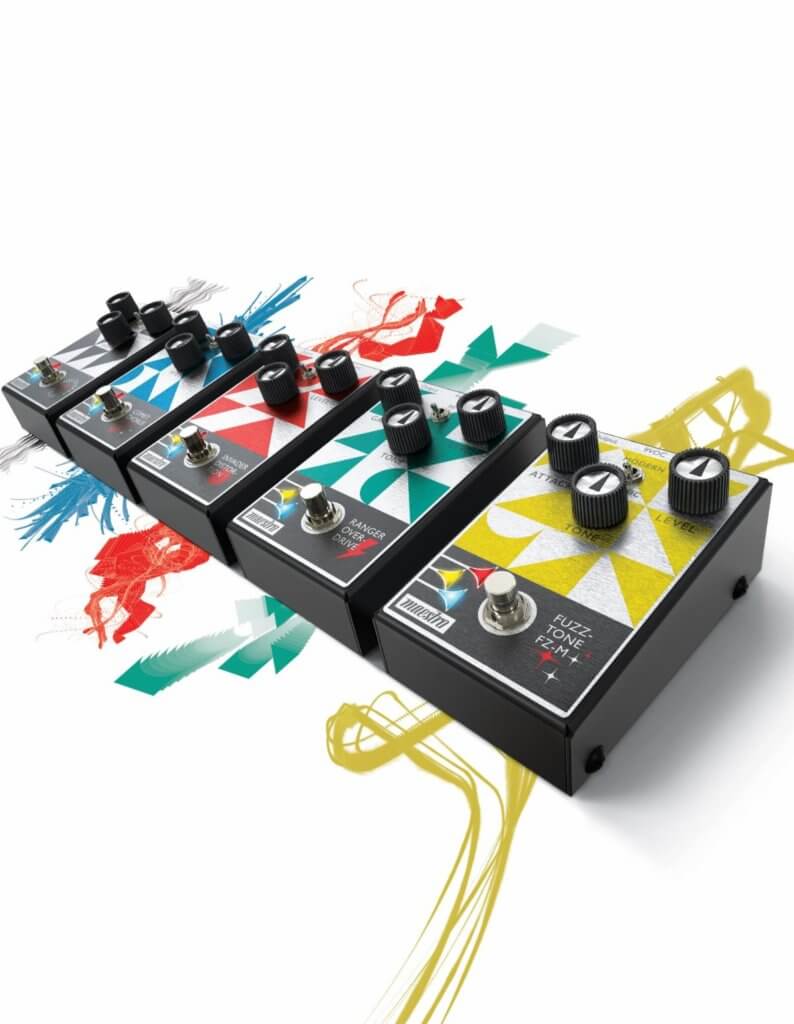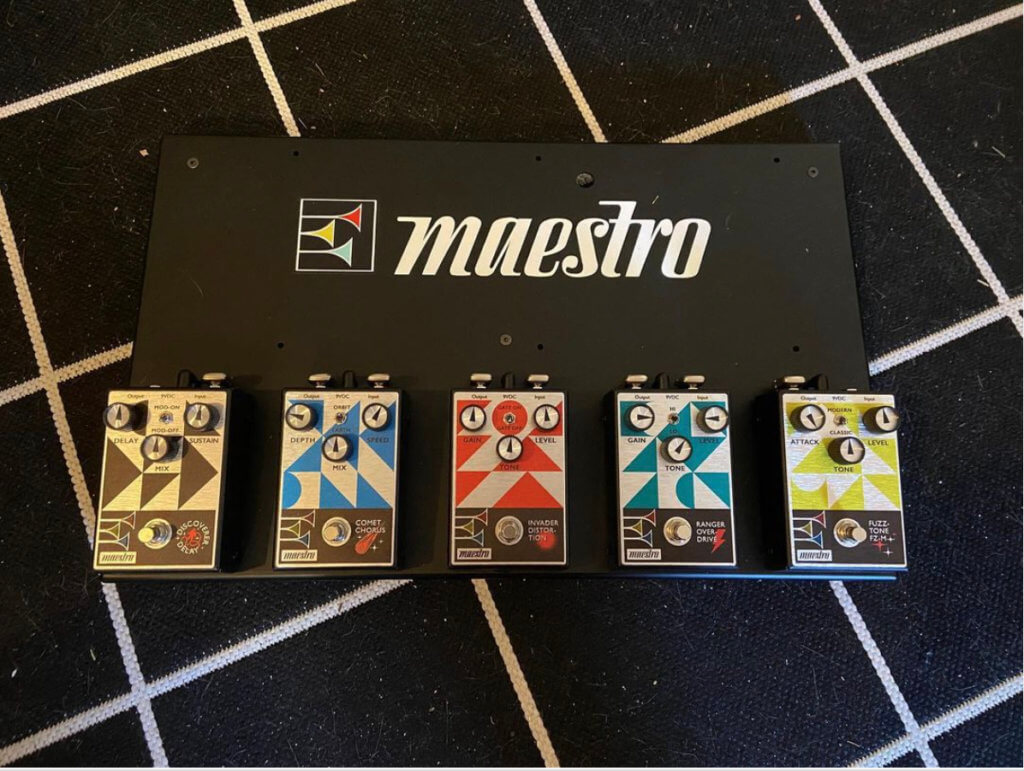With the recent re-launch of the Maestro brand from Gibson, we thought it would be fun to take a look at the entire lineup of pedals, evaluate each one, and review them.
So, we’re doing that…just not in here [check out our upcoming issue for that].
But it got us thinking – Maestro’s got a new fuzz, drive, distortion, chorus and delay coming out, so which order should we put them in on our pedalboard? Does it matter? Should we throw caution to the wind, be true renegades and put modulation stompboxes *gasp* in front of the amp and not the dedicated fx loop on the rear?
These questions and more will be answered…now.
What’s an FX Loop, Anyway?
Good question, and the first we plan on answering! If you have a decent amp, you may have noticed some jacks on the back collecting dust. Those, dear readers, are likely your fx loops, looking sad and unused. That’s because most of us neanderthal guitar plays just slap everything in front of the amp in whatever random order chaos theory has dictated, crank everything to 10, and then go on internet forums seven to ten minutes later to complain that we’re not getting the “tonez.”
So, the FX loop was meant to take time-based effects, like the killer new Discoverer Delay and Comet Chorus from Maestro (we’re obsessed with this chorus, btw) and put them where they belong. Out of sight! No, that’s not true. Out from in front of the amp, away from those nasty, nasty drives, distortions, fuzzes and otherwise messy-sounding units that gunk up your modulation effects. And who wants that?

Well, we do…sometimes. You see, kids, rules are meant to be broken. And in the world of rock and roll, both ways of doing things – the “right way” or otherwise – are perfectly valid. Try it yourself; we will say we oftentimes *prefer* putting modulation pedals in front of the amp because sometimes FX loops do funny things with volume dips, and sometimes the way a gnarly distortion box affects a wobbly chorus effect is KILLER.
And sometimes not, in which case you put that pesky chorus or reverb right back where it belongs! Loop! Loop! Loop!
That said, do show your underappreciated fx loop some love, and give it a go. If you like a touch of delay or reverb, throw ‘em in the loop and you might just clean up the “tonez” that those forum-dwellers couldn’t help you with.
BACK to the FRONT!
OK, so we’ve touched upon the oft-neglected and unloved loop situation. Now, the good stuff. The front of the amp is where your drive, fuzzes, and distortion pedals should live. They just sound better that way, trust us. Go ahead…waste 5 minutes putting them in the fx loop just to prove us wrong…we’ll wait.
You’re back? It wasn’t what you hoped for, was it? Ahem, as we were saying, the front of the amp is where the majority of your stompboxes will plug into. Hitting a drive pedal hard going into the front of a classic amp is just pure bliss, so why mess with success? Oh yeah, we said something earlier about breaking rules and whatnot. Well, sometimes rules are there for a reason!
Moving on…
What’s That Order, Again?
So, let’s look at the order that usually works the best when it comes to your pedalboard, going straight into the front of the amp.
We recommend something like this, but your mileage may vary (hey, it’s a free article, what do you expect?)
Volume, Expression and Dynamics
Typically, taming volume and dynamics just sounds best front and center, ESPECIALLY compressors. When you’re adding compression to a guitar signal, you’re balancing out the highs and lows in the volume range, which can even out the signal. You hear this a lot in country music, sure, but it’s super useful even in indie rock (some of you really should take more advantage of compressors, trust us). This type of effect should be applied near the beginning of the signal, and while you’re at it, we recommend throwing your volume or expression pedals here, as well.

Volume pedals, we feel, work best here because you can utilize it as a way to clean up or roll off a harsh signal before it hits your other fx and gets too muddy or blown-out. It’s just one way of doing it, of course, you could always experiment with it at the end, which some companies recommend so that you can control the entire signal, affected or not, before smashing into your time-based effects (hey, remember those!)
Turn The Gain Down a Tad, Skid Row
That’s an old joke from a comedy bit we barely remember, but it leads us nicely (or not, if you’re gonna be critical about our segues) into the next batch-o’-fx that should get wired into your pedalboard. We’re talking the Metal Zone, and ONLY the Metal Zone! Mwuah haha!
No, seriously, your drives and distortions should probably go here. Anything but the Metal Zone – something, perhaps, like the brand-spanking new re-imagining of the classic Maestro Fuzz, the FZ-M? If you haven’t been living under a rock like us, you’ll no doubt recognize the legendary, original Maestro Fuzz pedal from such classics as “Satisfaction” and about a million other tracks that brought fuzz to the mainstream.
So, if you, like us, want to get your fuzz on, pop it in the chain here. Or, for more saturated lead sounds without the wooliness, try slotting in an overdrive like the Maestro Ranger, or even take an extended holiday to Saturation Village with the Maestro Invader Distortion pedal.
Levity aside, we have been playing with these new Maestro stompboxes for a few weeks, and they’ve all been awesome additions to our pedalboard arsenal. We also dig the fact that they’re not coming in at boutique prices, either. Have you seen what Klons and Klon Klones are fetching on Reverb these days?
Anyway, back to the matter at hand. You’ve got your foot rocking the volume pedal, your other foot smashing the drive on full blast, and your third foot ready to engage the… the what?
Time Has Come Today…
Yes, your old friends the Time Bandits! You remember, the collection of time-based effects we previously tossed into the void that is the fx loop: chorus, delay, phasers, oh my!
Gain it up first, then time-squelch it later, I always say. And that formula seems to work well. Keeps things clean — it’s easy to remember, and you’ll hardly every go wrong.
If you have a wah, and you’re not named Saul or Kirk, this might be the best way to wrap-up your pedalboard’s layout. For some reason that smarter people than us can explain, wahs work at their best while sweeping through frequencies (basically acting like a big filter knob on an analog synth) AFTER all your other pedals are doing their business. This is especially true if you’re throwing gain in front of the wah, which is how we like it, and you likely will, too.
There are many more types of effects out there, some incredibly esoteric and expensive, that we won’t be covering here. But these are the main players, the heavy hitters, the stalwarts of the fx ecosystem that you’ll generally be encountering on your tone journey.
With a little forethought, some Velcro and a power supply, you too can whip just about any unwieldy pedalboard into ship-shape in no time.

our very own pedals card stocked with Maestro effects!
And with that, we must bid you adieu. Until next time, friends, keep smiling, keep stomping, knowing you can always count on us…to not take these things *too* seriously.
Guitar pedals should be fun, so for crying out loud, have fun with it. And send us what you come up with, we want to feature independent artists like YOU in each and every issue. Who knows, one day your weirdo pedalboard and it’s super-odd ordering of stompboxes could grace these pages and prove us, and the industry, wronger than wrong!
Before you go, though, do check out the new lineup of Maestro pedals and learn a little about their history, while you’re at it, all at https://www.maestroelectronics.com
And stay tuned for the next issue, where we (much more seriously) review each of the new excellent Maestro pedals.
